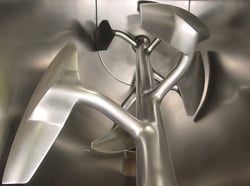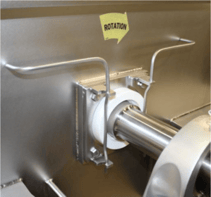3-A represents the pinnacle of quality for hygienic standards of processing equipment in the food, beverage and pharmaceutical industries. 3-A Standards are based on American National Standards Institute (ANSI) requirements and allows acceptance by USDA, FDA and state regulatory authorities. The standard exists so that you as a food processor can trust that your mixing equipment was made with fundamental sanitary safety features for food processing in mind.
 When you choose equipment that is designed to 3-A standards, you reduce the risks that can come with food processing. After all, if you are producing food for people, you have their well-being in mind. Even though the number one consideration for food processors is the cleanliness and sanitation of the equipment, many customers do not know what goes into manufacturing to 3-A standards.
When you choose equipment that is designed to 3-A standards, you reduce the risks that can come with food processing. After all, if you are producing food for people, you have their well-being in mind. Even though the number one consideration for food processors is the cleanliness and sanitation of the equipment, many customers do not know what goes into manufacturing to 3-A standards.
This article goes through the details of how Marion mixers meet 3-A standards and the value it creates. Specifically, we go into the metallic finish of the equipment surfaces, the inflow and outflow and the ease of cleaning the mixers.
Start with the Finish
Whether you are using a ribbon agitator, a paddle or a hybrid, the agitators have the most contact with the food being mixed, so the finish is extremely important. High-quality stainless-steel construction and a surface that resists corrosion are just the start. For foods, the lowest level of finish is 120 grit, with some food applications going up to 180 grit. Higher grit is used for applications where the manufacturer needs to clean between every batch, for perishables and for multi-use mixers, where the mixer is used for different foods and it’s important to get every micron of food out before starting a new mix. Similarly, any other parts of the machine that come in contact with the food need a highly polished finish for easy cleaning. Whether it is the valve pocket, doors, gaskets or the trough itself, every single part of the machine needs to have an extremely smooth finish for easy cleaning.
Another important step is eliminating any type of joint or crevice where particles can hide. For that reason, mixers that meet the standard have no bolted parts. Rather, you will see paddles that are completely welded and smooth. Similarly, the trough will be very smooth with no visible seams. It is difficult to do the tooling for smooth troughs —particularly when it comes to horizontal mixers. Ensuring that all surfaces and welds are smooth takes extra care and time. In-house tooling and precision quality assurance provides the basis for achieving sanitary standards, even with custom configurations.
Quality seal and gasket design: A key ingredient of 3-A Authorization
Sanitation is critical during mixing and removable seals and gaskets enhance the level of cleanliness. Food processors remove and clean the gaskets separately, preventing any build-up of  material surrounding the shaft and sealing the covers. For high throughput, having replaceable sets means you can clean one seal or gasket while the other set is in place for the mix being processed.
material surrounding the shaft and sealing the covers. For high throughput, having replaceable sets means you can clean one seal or gasket while the other set is in place for the mix being processed.
Flows for cleanliness
At Marion, all mixers must be easy to clean, involving a simple process to train an operator to clean and inspect the units. If it is not easy to inspect for the average operator, key areas could be missed. This requirement translates into easily visible parts with no hidden nooks and crannies that someone could miss with a visual inspection.
When constructing machinery to 3-A standards, it’s important to keep in mind every possible way in which a mixer might have areas where food or other residue could get stuck or where it might not be visible to the eye when making an inspection. Bolts are a warning sign—the crevices between bolts and the surface are difficult to clean, so if you see bolts, you probably are not looking at a machine that was built to rigorous 3A standards. Manufacturers need to make sure there are no crevices or un-welded joints that are exposed to food. Continuous welds can be implemented both internally in the trough as well as on the exterior. Lastly, when talking about horizontal mixers, ensuring that all surfaces are sloped can be a challenge and requires precision manufacturing, but it is absolutely required because it’s the only way to ensure that all surfaces drain moisture automatically.
Additional details such as the use of food-grade lubricants for the drive train, easy access for clean-in-place and rinse-in-place, and safety grates to ensure staff safety are included when you choose the right equipment for your food mixing application.
The bottom line
Fortunately, the 3-A entity that provides the standards to guarantee safety are highly qualified. Simply put, “When you pay for quality, you only wince once.” There could not be a more applicable mantra in the food industry – agreed?